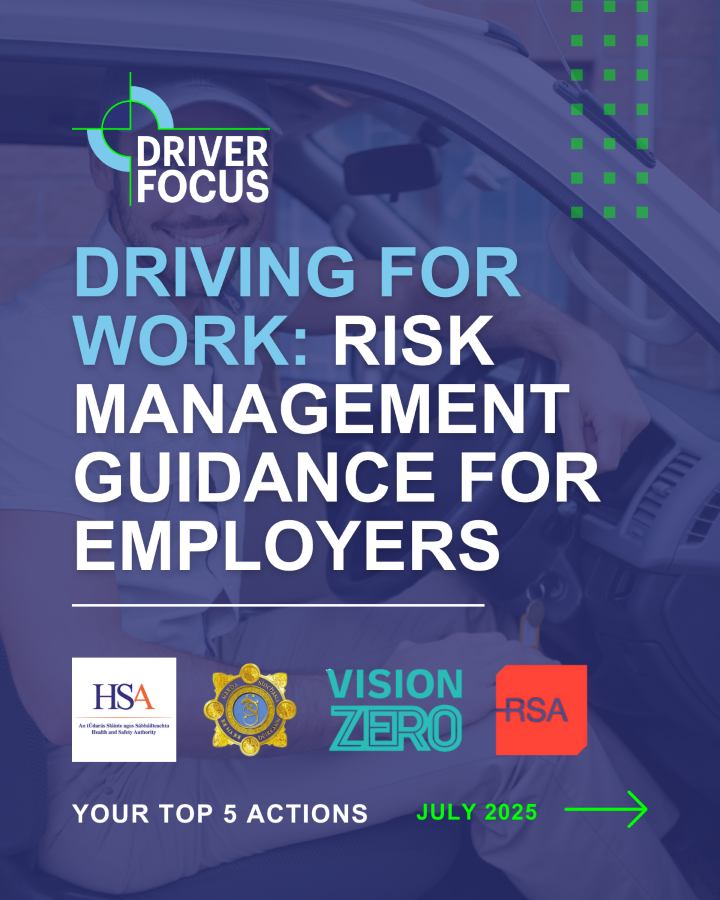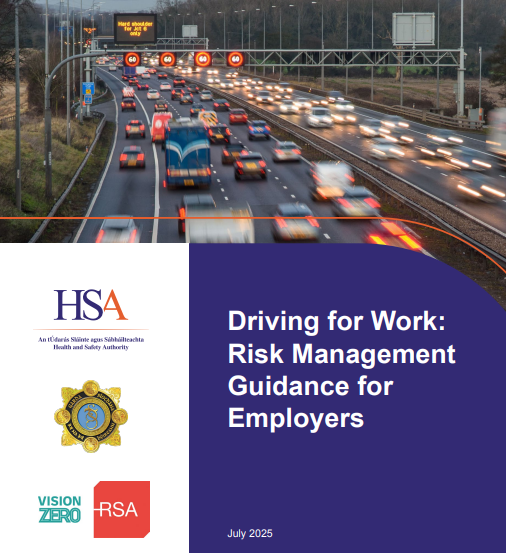Driving for Work Guidance: Your Top 5 Actions
When your staff drive for work, they’re not just “commuting” — they’re operating a mobile workplace. Often in Ireland, that workplace is dangerously overlooked.
The newly released “Driving for Work: Risk Management Guidance for Employers” (July 2025) is a wake-up call. It reaffirms what DriverFocus has long championed: managing driving risk isn’t optional — it’s a legal and moral duty with economic benefits.
DriverFocus was proud to be a key contributor to the original 2009 national guidance on driving for work. Today, we remain just as committed to helping employers turn risk into responsibility — and responsibility into results!
Here are our top five actions that your business must take without delay:
1. Acknowledge Driving for Work as a Health and Safety Risk
Driving for work is one of the highest-risk activities your staff engage in. The RSA reports that up to 40% of road deaths are work-related [1]
Action: Explicitly list “driving for work” as a hazard in your Safety Statement — if it’s not written down, it’s not being managed. [2]
2. Build — and Enforce — a Driving for Work Policy
The 2025 guidance demands clarity and shared accountability. Employers must define roles, expectations, reporting and training — including coverage of personal vehicles used for work, also known as the “grey fleet.” [3]
Action: Create or update your Driving for Work Policy using the RSA sample in Appendix A, then communicate it to all workers, contractors and grey fleet drivers.
3. Check the Licence — Every Licence
Too many companies assume drivers are licensed, insured and medically fit — a risky assumption that no longer holds water. [4]
Action: Implement formal, annual licence checks for all drivers — including grey fleet.
[Tip: PERMIT supports secure and auditable checks].
4. Train Against the Big Killers: Fatigue, Speed and Distraction
The RSA's 2024 survey data confirms that those who drive for work are more likely to speed, use phones while driving, or drive while fatigued — the “big three” risks. [5]
Action: Introduce safety monitoring, incident reporting and targeted coaching. Prioritise training that addresses real-world driver behaviour, not just theory.
5. Proactively Monitor and Improve
Compliance is not a one-off. Employers must track near misses, update risk assessments and continuously review performance. [6]
Action: Appoint a named individual responsible for fleet risk and use technology to collect driver, vehicle and journey data. Use leading indicators — not just crash data — to drive improvement.
👉 Ready to Take the Wheel? The law is clear and the risks are real — but the solutions are within reach.
Services:
PERMIT - online driving licence verification
SURVEY - online driver risk assessment
DRIVEALERT - online defensive driver training
DRIVESAFE - ADI-led interactive webinar courses
ALLY - mobile telematics for speed awareness
SAMSARA - AI video telematics to target training
Contact us today and see how our services can help you stay compliant and go beyond it to build a better culture of care.
Simply click to sign-up.
Whether your focus is business mileage compliance or driver safety and duty of care, we’re here to help you achieve better outcomes every time staff drive for work.
Every two months, we’ll share insights, resources and templates to make compliance simpler and driver wellbeing stronger.
Sources
[1] RSA Driving for Work Guidance (2025), p.6: Up to 40% of road deaths are work-related.
[2] RSA Driving for Work Guidance (2025), p.8: Driving for work must be listed as a hazard in your Safety Statement.
[3] RSA Driving for Work Guidance (2025), pp.12 & 17: Driving for work policy and grey fleet management.
[4] RSA Driving for Work Guidance (2025), p.16: Annual licence and fitness checks are essential.
[5] RSA Driving for Work Guidance (2025), pp.18–22 & 31: Survey confirms higher risk of speeding, distraction, fatigue among work drivers.
[6] RSA Driving for Work Guidance (2025), pp.32–33: Ongoing monitoring, review and data use is required.



